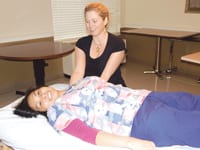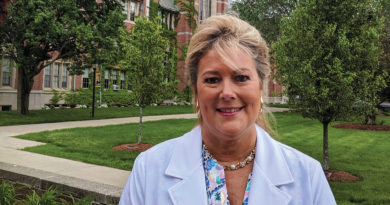Healing Touch – Bottom-Line Bodywork Brings Massage to the Workplace
Twice each week, the assisted dining room at the Life Care Center of Wilbraham is transformed into a quiet, relaxing oasis.
The blinds are drawn, and soothing music plays softly as employees enter the dimly lit room and are treated to a 15-minute massage designed to alleviate stress, treat aches and pains, and allow them to return to work feeling rejuvenated and ready to help the people they care for.
The service is provided by Bottom-Line Bodywork, LLC in Palmer, which brings massage therapy into the workplace with a focus on nursing homes, assisted-living facilities, hospitals, and doctors’ offices.
“We specialize in short, targeted sessions to reduce tension, relieve stress, and help prevent carpal-tunnel and other repetitive-motion injuries,” said founder and CEO Saskia Cote, explaining that all massages are done on a massage table as opposed to a massage chair, which allows people to lie down and completely relax.
Although Life Care Center Senior Executive Director Dennis Lopata says the free massages are a simple perk, the benefit is appreciated and important to employees whose work duties include lifting people, assisting them with ambulation, and helping with tasks necessary to daily living.
“The job can be really demanding, especially for certified nursing assistants, who use and abuse their bodies to meet everyday challenges,” Lopata told HCN. “The signup sheets fill quickly every week, and employees tell me the service makes them feel like Life Care cares about their personal well-being. It’s a well-regarded service, and we are happy to have Saskia as part of our team.”
Life Care Center is one of a growing number of companies that are incorporating massage therapy into wellness programs. Studies show the alternative health practice is an effective treatment for stress and pain relief, and doctors and healthcare professionals endorse its benefits.
Research has demonstrated that, in addition to decreasing stress, anxiety, and depression, massage therapy relieves muscle tension and pain, improves sleep, helps headaches, lowers blood pressure, prevents repetitive-strain injuries, increases immune function, treats carpal tunnel and tendinitis, and increases focus, energy, and mental clarity.
A recent study by Beth Israel-Deaconess Center for Alternative Medicine Research and Education and the Center for Health Studies in Seattle concluded that therapeutic massage is an effective treatment for chronic low back pain, while other workplace studies show it results in reduced absenteeism and workers’ compensation claims.
Indeed, it has become a benefit that pays for itself. According to the “2015 Report on Corporate Wellness” by IBISWorld, corporate wellness programs that include massage therapy average a $3 to $6 return on every dollar of investment.
Life Care has not been able to quantify benefits in terms of a dollar amount, but Lopata believes workers’ compensation claims and sick days have been reduced as a result of the massages that several dozen employees take advantage of each week.
Restorative aide Deborah Rivera is a proponent of workplace massage and has donated her time to peers who are having a difficult day and aren’t on the schedule.
“We try to provide every resident with the utmost in care, but sometimes we can’t do everything we would like to. We see some heartbreaking situations,” she said as she spoke about dementia and other age-related illnesses. “But this takes us away from the unit and puts us in a different stage of mind. We are being cared for and attended to, which is very relaxing.”
She added that a single session has alleviated back pain that stemmed from lifting and transferring patients. “When I leave the massage room, I feel rejuvenated and ready to go back on the floor and be a super aide.”
Winsome Roberts is another massage advocate who signs up for massages at Life Care every week. “I used to get a lot of migraine headaches, but they stopped after several months of massage,” said the certified nursing assistant. “Fifteen minutes may not seem like much, but it helps me to be more relaxed and flexible. The job can be physically and mentally demanding, but this makes a real difference and helps me to help residents who need assistance.”
Healing Journey
Cote has been a licensed massage therapist for 25 years, and has taught massage therapy to students in the U.S. as well as seven foreign countries.
She grew up in the Netherlands and began bodywork training at the Upledger Institute Europe in 1990.
She moved to the U.S. following a spiritual retreat to Santa Fe, N.M., where she learned about the New Mexico Academy of Healing Arts and was accepted into the program.
“I fell in love with massage there,” she said, adding that, after graduation, she worked at Ten Thousand Waves Spa in Santa Fe, which has been consistently named one of the top 10 spas in the world.
In 2002, Cote and her husband left New Mexico and moved to Massachusetts because they wanted to live closer to his family in the Boston area. They settled in Palmer, and she began work as an independent massage therapist. She also taught massage therapy at the Muscular Therapy Institute in Watertown, which recently changed its name to the Cortiva Institute. She was promoted to director of the institute’s continuing-education program and continued in that role until three years ago, when she left to teach at the Massage School in Easthampton.
During a time when she was questioning what else she could do with her life, she received a phone call about a counseling program at Elfinstone College in Rockport. She enrolled and graduated in 2008 with a doctorate that proved to be an important adjunct to her career.
“People store emotions and memories of trauma in their bodies, which sometimes come out when they are touched with compassion,” Cote told HCN, recalling people who received massages after 9/11 and began crying on the massage table.
Three and a half years ago, she was hired to replace a massage therapist working for the Life Care Center in Wilbraham, and the joy she found helping people in the workplace led Cote to found Bottom-Line Bodyworks in 2015.
In addition to massage therapy, she is trained in a number of other healing modalities that include craniosacral therapy, myofascial release, lymphatic drainage, Reiki, and Qi Gong. She also offers hot-stone massage and cupping, which is popular with nursing-home employees because it helps with pain and inflammation while providing a sense of well-being.
“People often think of massage as a luxury, but when they have the opportunity to get a massage at work, it becomes part of their self-care,” Cote said, adding that it helps employees in nursing homes alleviate stress and physical discomfort in their knees, backs, and shoulders that results from working on their feet all day or lifting residents.
Cote also enjoys being able to provide local therapists with work, especially since it can be difficult for them to maintain a steady flow of clients. She has two employees and plans to hire a third in the Foxboro area, as a company there has requested her firm’s services.
In December, Wingate at Wilbraham signed a six-month contract with Body-Line Bodywork, and employees began signing up for weekly massages last month.
Administrator Darryl LeCours said the money for the service came from an $11,000 Pay for Performance Award the facility received last year from the state. The award has to be spent on staff, and after taking a poll and holding meetings to see what employees preferred, it became evident that their top choice was massage.
“Things such as gift cards or food for the break room, which were suggested, have a very short-lived impact,” she noted. “Massage is therapeutic and something tangible we can do to help employees have a better week physically and mentally.”
LeCours added that certified nursing assistants and other front-line caregivers are often exhausted at the end of a shift. But she noted that everyone has a smile on their face when they come out of a session.
“We’re trying to bring happiness into the nursing home, and it’s important for our employees to feel good so they can provide compassionate care to our residents,” LeCours said.
Other companies have called upon Body-Line Bodywork to give massages at employee-appreciation days and similar events, and their numbers are growing.
Beneficial Effects
When Cote arrives at a nursing home, the signup list is always full, and on a recent day, employees at Life Care Center kept stopping by for shoulder or back therapy even though they weren’t on the schedule.
Although it’s difficult to quantify the therapeutic benefits of this service, people have reported they are less anxious, sleep better, and have enjoyed better health as a result of massage.
It also provides them with a refuge from stress in a temporary oasis created expressly for that purpose.
“It’s a nice 15 minutes of silence that allows me to put everything in perspective,” said Ann Caseldan, a speech-language pathologist at Life Care who has enjoyed massages for the past two years.
Hazel Ferriter agrees. She usually signs up for a massage before her 12-hour shift at Life Care Center begins. “It loosens up your muscles and has helped me with a migraine and back pain that comes from lifting. Massage makes you feel better,” said the certified nursing assistant.
Indeed, it’s a win-win situation. “People are always happy to see me, which brings me great joy,” Cote said. “When they receive a massage, they learn how to touch the residents in a healing and loving way and may be able to go the extra mile for a patient because they feel nurtured themselves. It’s a ripple effect of compassionate touch; once someone is touched with love and compassion, they are much more likely to be loving and compassionate towards others.”
Which is a priceless benefit, especially in settings where employees care for loved ones who can no longer care for themselves.





Comments are closed.